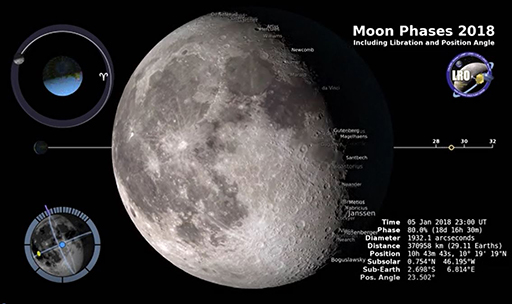2.10 Moon phases and libration
As viewed from the Earth, the disc of the Moon undergoes a complete waxing (growing) and waning (shrinking) cycle of phases once every 29 days, as varying amounts of the lunar near-side surface are illuminated by the Sun. The extent of illumination of the Moon’s surface depends on where the Moon is at the time, in relation to the Earth and Sun.
The video here shows the Moon’s phases throughout the year 2013. Concentrate on the main picture rather than the information around the edges. As well as the phase changes, you will notice it changing a little in apparent diameter as its distance from the Earth varies. You will also see it swinging slightly from side to side. This is called ‘libration’ and is because the Moon’s varying orbital speed alternately gets slightly ahead of and then lags slightly behind its constant rate of rotation.
If the Moon’s orbit takes it exactly between the Earth and the Sun, then the Sun is hidden by the Moon, causing a solar eclipse, but because the Moon’s orbit is inclined this rarely happens.

If you wanted to look into this further, you might find the following link of interest: Moon phases and libration. If you want to explore the Moon’s orbital relationship with the Earth more fully than in this video, you can find explanations and other videos at this link, as well as a video of Moons phases during the current year.
